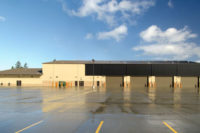
Building integrated photovoltaics were installed on the roof of the Slavin Center. Photo by John Scott, AIA, Symmes Maini & McKee Associates Inc.
When embarking on a sustainable plan that has the potential to transform a campus, why not start with a highly visible bang? Providence College in Providence, R.I., recently seized such an opportunity by installing thin-film building integrated photovoltaics on the roof of the Slavin Center, the college’s student center. “The college is in the process of putting together a campus sustainability plan. This construction project allowed us the opportunity to take advantage of the nonobstructed south-facing orientation of the addition for the photovoltaics,” said Mark Rapoza, assistant vice president for capital properties and facilities planning for Providence College.
The college chose ATAS International’s ATA-Solar BIPV system. ATA-Solar is available in different panel options, but the center’s roof consists of 24-gauge steel standing-seam roofing panels in a Silversmith color with a thin-film amorphous silicon laminate applied. In all, 4,880 square feet of metal roofing and 72 18-foot laminates were installed. The laminates have a rating of 136 watts DC each, yielding a total system rating of 9.792 kW.
The college selected the metal roof for aesthetics as well as chose the sustainable material because of its minimal maintenance. When comparing solar system options, BIPV stood out because of its effectiveness. “Based upon our usage, budget and the life expectancy of the various options, the integrated design was the most efficient for the college,” Rapoza said.
Jim Bush, vice president of sales for ATAS, added: “ATA-Solar is an attractive system that gave the university the look it wanted as well as an efficient, low-maintenance energy source.”
Providence College called on architectural firm Symmes Maini & McKee Associates of Cambridge, Mass., to design the addition and, thereby, create a new entrance for the Slavin Center and transform the existing usable space. The firm also was asked to improve the aesthetics of the Slavin Center, which opened in 1971. “The architecture of the late 60s/early 70s was less than attractive by most opinions,” Rapoza explained. “The hope was that the addition would add a new façade to the existing [structure], which was heavily dominated by brick/concrete. The newly constructed glass atrium allows for natural light and a space that is far more welcoming.”
The project consisted of expanding the south side of the building with a two-level addition, which encompasses a total of 8,800 square feet of new space and 560 square feet of renovated space on three levels. The lower level of the two-level addition contains a student lounge with an adjacent coffee and snack shop. The upper level consists of a quiet student lounge. The primary renovations to the existing building were the expansion of studio space for WDOM-FM radio and PCtv.
John Scott, AIA, ACHA, principal and project director for SMMA, led the design effort and believes the addition has transformed the Slavin Center. “It is light, airy, transparent and very inviting during all hours of the day. You can now see the activities within. It has become the magnet of the center, the sustainability workshop, the centerpiece of the Common and the backdrop for commencement activities.”
Those interested in observing the BIPV system at work can watch daily panel outputs on a flat-screen monitor in the center’s lower level or visit www.tinyurl.com/yaelo6e. And as any proper collegiate institution should, Providence College is putting its cool roof to use in the classroom. “We had hoped that the installation of the panels, along with other sustainable initiatives in the project, would be somewhat of an educational element of the project,” Rapoza said. “We have scientists and students using the information generated on the website in a number of classes.”
